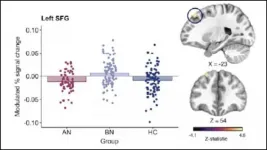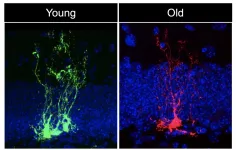(Press-News.org) WOODS HOLE, Mass. -- Nitrogen is an element basic for life -- plants need it, animals need it, it's in our DNA -- but when there's too much nitrogen in the environment, things can go haywire. On Cape Cod, excess nitrogen in estuaries and salt marshes can lead to algal blooms, fish kills, and degradation of the environment.
In a study published in Environmental Research Letters, scientists at the Marine Biological Laboratory (MBL) Ecosystems Center examine ways to reduce the nitrogen footprint of smaller institutions, like the MBL, by focusing on a bottom-up approach.
"This bottom-up approach is all about balancing the needs of various stakeholders to come up with the best, most feasible solution for the institution," says Sarah Messenger, lead author and research assistant in the MBL Ecosystems Center.
At the MBL, and many institutions like it, the biggest sources of nitrogen are food production and consumption. That's because nitrogen is used as fertilizer to grow our food and produce the feed that supports livestock animals.
Researchers found that switching to an all-vegan diet (no animal products) in dining halls would make a huge dent in the institution's nitrogen footprint, but MBL's dining team called it a non-starter. The kitchen staff isn't trained for that, nor would the customers be open to it, they said. It would also mean big changes for the department's budget.
"The problem here is not just at an institutional level, but at a family level, at the community level, at regional, state, and national levels. The problem is that these things cost a lot of money and they are difficult to implement," says Javier Lloret, MBL research scientist.
The scientists also found that upgrading the institution's HVAC systems, fitting new, more efficient windows, or going 100% solar could cut the institution's nitrogen footprint. But all of those solutions come with a large price tag.
"The MBL is really small, so we don't have the personnel resources of larger Institutions," says Messenger. "We don't have a sustainability department. We have limited manpower, limited resources, and limited money that we can put towards making these big changes."
But what the MBL and many smaller institutions have are people who are experts at what they do. So instead of searching for a solution to the institution's nitrogen footprint that could require a large budget commitment from the director or the board of trustees, the scientists identified on-the-ground stakeholders in the departments that were responsible for the biggest portion of MBL's nitrogen footprint--food and facilities--and modeled "low-effort" solutions for those departments. They focused on ideas that didn't require new personnel, a large investment or a change in normal operations, and could be accomplished over the short term (three to five years).
"The goal was to only model changes that these department leaders could implement in their departments without needing sweeping changes and institution approval," says Messenger, adding that the team "completely disregarded any reduction strategies that weren't acceptable to the people that know their department best."
For dining services, an all-vegan or all-vegetarian menu was a no-go, but replacing 20% of MBL's beef use with chicken or fish resulted in a 2.6% reduction in the institution's nitrogen footprint, according to the researchers' model. Swapping out 10% of meat meals with vegetarian options would reduce the MBL's nitrogen footprint by 5.7%. They found that serving less meat could also result in a reduction of costs to the catering department.
The MBL's facilities team was already implementing an upgrade of the institution's lighting, so the research team adding those upgrades to their model -- calculating a 7.3% drop in the nitrogen footprint of the utilities sector and a 2% drop in the MBL's overall nitrogen footprint. Purchasing extra renewable energy credits to power the MBL with solar energy was also modeled.
Combining all the approaches, the scientists calculated a 7.7% drop in the MBL's nitrogen footprint with no major disruption to operations and no additional monetary support from the institution.
"It might not seem like a lot, but 8% is a lot of nitrogen," said Lloret. "These small changes do make a difference."
While no measures have been implemented yet, the team said they were optimistic by the response from the department stakeholders and hoped that the MBL, and other small institutions like it, could use this paper to examine ways to minimize their nitrogen and carbon footprints.
"We all want the same thing," says Messenger. "We would all love the MBL to reduce the impact on our environment as much as possible, but exactly how to get there is challenging. We're hoping that this paper can be a map forward."
INFORMATION:
Other co-authors include MBL Ecosystems Center Director Anne Giblin and MBL Trustee James Galloway.
The authors of the paper wanted to thank MBL's Erin Hummetoglu, Marie Russell, and Bill Brosseau for their contributions to this project.
The Marine Biological Laboratory (MBL) is dedicated to scientific discovery - exploring fundamental biology, understanding marine biodiversity and the environment, and informing the human condition through research and education. Founded in Woods Hole, Massachusetts in 1888, the MBL is a private, nonprofit institution and an affiliate of the University of Chicago.
By Emily Greenhalgh
When winter storms threaten to make travel dangerous, people often turn to salt, spreading it liberally over highways, streets and sidewalks to melt snow and ice. Road salt is an important tool for safety, because many thousands of people die or are injured every year due to weather related accidents. But a new study led by Sujay Kaushal of the University of Maryland warns that introducing salt into the environment--whether it's for de-icing roads, fertilizing farmland or other purposes--releases toxic chemical cocktails that create a serious and growing global threat to our freshwater supply and human health.
Previous studies by Kaushal and his team showed that added salts in the environment can interact with soils and infrastructure to release a cocktail of metals, ...
Researchers have genetically engineered a probiotic yeast to produce beta-carotene in the guts of laboratory mice. The advance demonstrates the utility of work the researchers have done to detail how a suite of genetic engineering tools can be used to modify the yeast.
"There are clear advantages to being able to engineer probiotics so that they produce the desired molecules right where they are needed," says Nathan Crook, corresponding author of the study and an assistant professor of chemical and biomolecular engineering at North Carolina State University. "You're not just delivering drugs or nutrients; you are effectively manufacturing the drugs or nutrients on site."
The study focused ...
Spanking may affect a child's brain development in similar ways to more severe forms of violence, according to a new study led by Harvard researchers.
The research, published recently in the journal Child Development, builds on existing studies that show heightened activity in certain regions of the brains of children who experience abuse in response to threat cues.
The group found that children who had been spanked had a greater neural response in multiple regions of the prefrontal cortex (PFC), including in regions that are part of the salience network. These areas of the brain respond to cues in the environment that tend ...
Energy flows through a system of atoms or molecules by a series of processes such as transfers, emissions, or decay. You can visualize some of these details like passing a ball (the energy) to someone else (another particle), except the pass happens quicker than the blink of an eye, so fast that the details about the exchange are not well understood. Imagine the same exchange happening in a busy room, with others bumping into you and generally complicating and slowing the pass. Then, imagine how much faster the exchange would be if everyone stepped back and created a safe bubble for the pass to happen unhindered.
An international collaboration of scientists, including UConn Professor of Physics Nora Berrah and post-doctoral researcher ...
New York, NY - Major depressive disorder is highly prevalent, with one in five people experiencing an episode at some point in their life, and is almost twice as common in women than in men. Antidepressants are usually given as a first-line treatment, including during pregnancy, either to prevent the recurrence of depression, or as acute treatment in newly depressed patients. Antidepressant use during pregnancy is widespread and since antidepressants cross the placenta and the blood-brain barrier, concern exists about potential long-term effects of intrauterine antidepressant exposure in the unborn child.
Using the Danish National Registers to follow more than 42,000 singleton babies born ...
Stress alters brain activity in self-inhibition areas yet doesn't trigger binge-eating, according to new research published in JNeurosci.
People who binge-eat, a hallmark symptom of several eating disorders, can feel out of control and unable to stop, and often binge after stressful events. This led scientists to theorize stress impairs the brain regions responsible for inhibitory control -- the ability to stop what you are about to do or currently doing -- and triggers binge-eating.
Westwater et al. tested this theory by using fMRI to measure the brain activity of women with anorexia, bulimia, or without ...
A unique residential study has concluded that, contrary to perceived wisdom, people with eating disorders do not lose self-control - leading to binge-eating - in response to stress. The findings of the Cambridge-led research are published today in the Journal of Neuroscience.
People who experience bulimia nervosa and a subset of those affected by anorexia nervosa share certain key symptoms, namely recurrent binge-eating and compensatory behaviours, such as vomiting. The two disorders are largely differentiated by body mass index (BMI): adults affected by anorexia nervosa tend to have BMI of less than 18.5 kg/m2. More than 1.6 million people in ...
In a new study published in Cell Stem Cell, a team led by USC Stem Cell scientist Michael Bonaguidi, PhD, demonstrates that neural stem cells - the stem cells of the nervous system - age rapidly.
"There is chronological aging, and there is biological aging, and they are not the same thing," said Bonaguidi, an Assistant Professor of Stem Cell Biology and Regenerative Medicine, Gerontology and Biomedical Engineering at the Keck School of Medicine of USC. "We're interested in the biological aging of neural stem cells, which are particularly vulnerable to the ravages of time. This has implications for the normal cognitive decline that ...
Researchers have used a technique similar to MRI to follow the movement of individual atoms in real time as they cluster together to form two-dimensional materials, which are a single atomic layer thick.
The results, reported in the journal Physical Review Letters, could be used to design new types of materials and quantum technology devices. The researchers, from the University of Cambridge, captured the movement of the atoms at speeds that are eight orders of magnitude too fast for conventional microscopes.
Two-dimensional materials, such as graphene, ...
New research from McMaster University suggests the pandemic has created a paradox where mental health has become both a motivator for and a barrier to physical activity.
People want to be active to improve their mental health but find it difficult to exercise due to stress and anxiety, say the researchers who surveyed more than 1,600 subjects in an effort to understand how and why mental health, physical activity and sedentary behavior have changed throughout the course of the pandemic.
The results are outlined in the journal PLOS ONE.
"Maintaining a regular exercise program is difficult at the best of times and the conditions surrounding the COVID-19 pandemic ...




